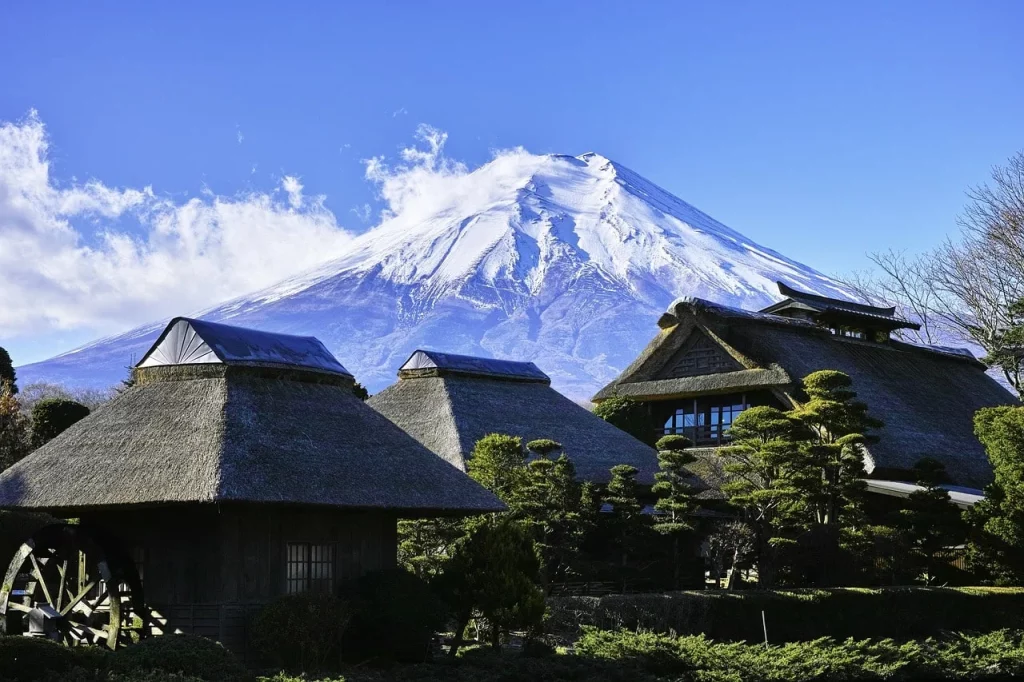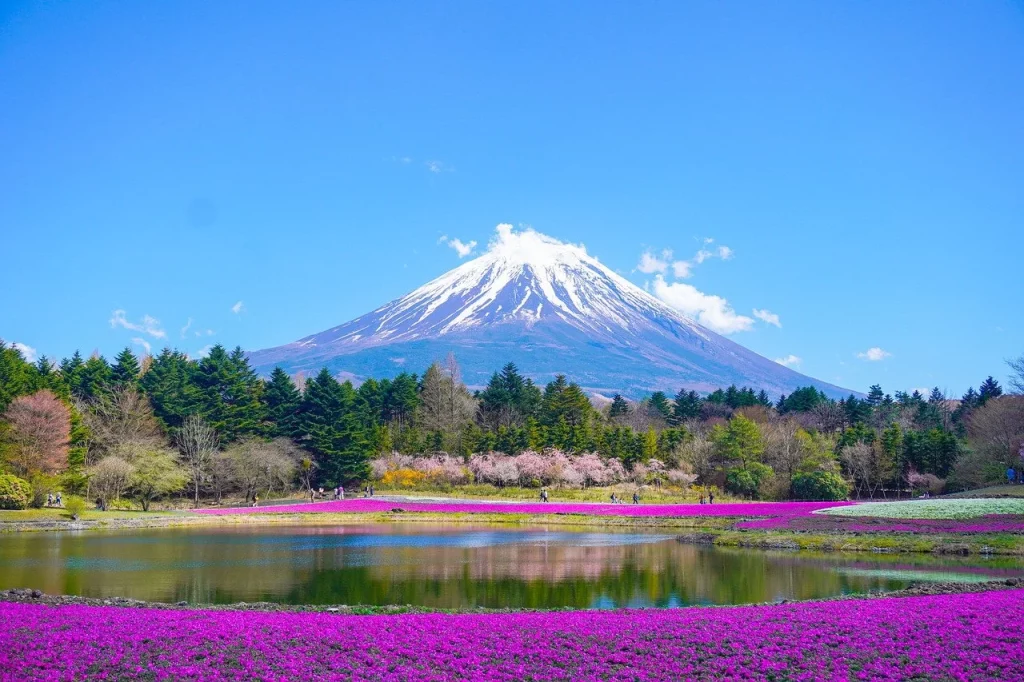Mount Fuji, with its majestic stance and serene beauty, has whispered secrets to the winds for centuries. Today, we’re going to be the wind, carrying some intriguing facts about Japan’s iconic mountain to you. From its historic eruptions to its role in art and literature, every fact paints a stroke in the portrait of Mount Fuji.
And just when you thought you knew all there was to know about mountains, think again. Did Mount Fuji ever send a postcard to the Alps, bragging about its beauty? Let’s climb into the heart of these stories. Are you prepared to be surprised by what you’ll discover about it?
Mount Fuji, in its unutterable perfection, is the enduring symbol of Japan.
Hokusai Katsushika
Mount Fuji Facts
Dive into the wonders of Mount Fuji with me, but keep in mind that a quiz lies at the bottom of this page. Absorb every detail to ace the quiz. Don’t disappoint me.
- This iconic peak has a perfectly symmetrical cone shape, which is a rare natural occurrence.
- It is not just one volcano, but three separate volcanoes stacked on top of each other.
- The mountain’s summit is cold enough to sustain snow year-round, despite its location in a relatively temperate climate zone.
- It is considered one of the most climbed mountains in the world, with over 300,000 people attempting the ascent each year.
- The mountain’s base is surrounded by five beautiful lakes, offering breathtaking reflections of the peak.
- The first ascent by a foreigner was recorded in 1860 by Sir Rutherford Alcock, making it a relatively late discovery for the Western world.
- Its last eruption occurred in the early 18th century, specifically in 1707, marking over 300 years of dormancy.
- Aokigahara, also known as the Sea of Trees, lies at its northwestern base and has a reputation for mysteries and legends.
- The peak is home to several revered Shinto shrines, highlighting its cultural and spiritual significance.
- It is a UNESCO World Heritage Site, not only for its natural beauty but also for its cultural impact on Japanese art and literature.
- The visibility of the peak from Tokyo, over 100 kilometers away, is considered a rare and auspicious event.
- The mountain’s iconic profile is featured on the 1000 yen note, emphasizing its national importance.
- There’s a phenomenon known as “Diamond Fuji”, where the sun sets perfectly atop the peak, creating a sparkling effect.

- Its elevation, officially measured at 3,776 meters, makes it the highest point in Japan.
- A weather phenomenon unique to the mountain, known as the Fujiwara effect, involves cyclic patterns of air movement around the peak.
- The climb to the summit does not require professional mountaineering equipment, making it accessible to a wide range of people.
- Despite its serene appearance, the volcano is classified as active, with a potential threat of future eruptions.
- Its isolation and prominence in the landscape have made it a subject of worship and pilgrimage for centuries.
- The first recorded ascent was made by a monk in 663, showcasing its long history of human interaction.
- The peak’s snowcap, visible for several months a year, symbolizes purity in Japanese culture.
- It has inspired countless works of art, including the famous woodblock print series “Thirty-Six Views of Mount Fuji” by Hokusai.
- The surrounding region is known for its rich biodiversity, including several endemic species.
- Paragliders often take off from its slopes, taking advantage of the unique air currents generated by its mass.
- Its name means “Immortal” in Japanese, reflecting its enduring presence in the country’s landscape and culture.
- The temperature at the summit can drop below -20°C in winter, despite its relatively southern latitude.
- It acts as a barrier, influencing the weather patterns between the Pacific coast and the interior of Honshu.
- The mountain’s silhouette has been a symbol of return and hope for Japanese expatriates and travelers.
- There’s a specific type of lava found only on its slopes, named Fuji lava, distinguished by its texture and composition.

- The sunrise from its summit, known as Goraiko, is considered a spiritual experience by many climbers.
- The Gotemba walking trail is the longest route to the summit, offering less crowded paths and stunning views.
- Its peak is a crater 250 meters deep, a reminder of its volcanic nature.
- There are over 200 caves formed by lava flows at the base of the mountain, offering unique geological explorations.
- The presence of ice caves near the summit is unusual for a volcano, caused by cold air trapped in the basalt.
- It is considered a living volcano, with scientists closely monitoring for signs of activity.
- Its formation is linked to the Philippine Sea Plate subducting under the continental Eurasian Plate.
- The Ohachi, its main crater, is surrounded by eight smaller peaks forming a circular pattern.
- The climbing season is officially limited to the summer months, from July to early September, to ensure safety.
- Its isolated position has made it an important landmark for navigation, both for ships at sea and for travelers on land.

- The Oyama town located at its base is known for a unique delicacy: noodles made with water from the mountain’s springs.
- It generates its own weather system, capable of creating sudden storms and rapid changes in weather conditions.
- The Yoshida Fire Festival, held annually in its honor, is one of Japan’s three most unique festivals.
- Despite its beauty, the climb is challenging, with a saying that goes: “He who climbs once is a wise man; he who climbs twice is a fool.”
- It has been featured in numerous films, animations, and literature, becoming a global icon of Japan.
- Environmental efforts are in place to protect its natural beauty, including restrictions on development and waste management initiatives.
- The mountain’s shadow cast at sunrise and sunset can stretch across the landscape, creating an impressive visual phenomenon.
- There is a specific species of butterfly, the Fuji butterfly, that is said to inhabit only its slopes.
- The ascent routes are dotted with stations that offer not just rest and refreshment but also cultural insights, showcasing the mountain’s historical and spiritual significance.
- Its geological history is complex, involving over several hundred thousand years of volcanic activity to reach its current form.
- The peak is a popular subject for haiku poetry, symbolizing nature’s beauty and the ephemeral quality of life in Japanese culture.
- An undersea mountain, named Fuji San, was discovered off the coast of Japan, mirroring the iconic shape of its terrestrial counterpart.
Mount Fuji Myths

Facts checked, imagination unlocked! We’re going beyond the guidebooks and into the fantastical realm of Mount Fuji’s myths. Are you ready to separate truth from folklore?
- Mount Fuji is Always Covered in Snow
In reality, it is not perpetually capped with snow. Its snow cap is prominently visible from about November to around May. During the summer months, climbers and visitors often witness its mostly barren, volcanic rock surface. - Mount Fuji Can Be Climbed Any Time of the Year
Contrarily, the official climbing season is very short, from early July to early September. Outside of this period, the trails are closed, and climbing is strongly discouraged due to severe weather conditions and safety concerns. - Mount Fuji is an Active Volcano That Erupts Frequently
In fact, it is classified as an active volcano but has not erupted since its last eruption in 1707-1708. It is closely monitored for any activity, but eruptions are not considered frequent by any measure. - Climbing Mount Fuji is an Easy Task for All
Climbing it is actually a challenging endeavor, requiring physical preparation and proper gear. The climb is steep and can be quite demanding, especially due to the altitude and potential weather changes. - Mount Fuji is Isolated and Remote
On the contrary, it is highly accessible and surrounded by a well-developed infrastructure. It’s located near Tokyo and is well-connected by public transportation, making it a popular destination for both tourists and locals.
No products found.
Mount Fuji FAQ

Next up: the FAQs. We’re on the last leg before the quiz, so it’s essential to grasp these final pieces of information to ensure you’re ready.
- How was Mount Fuji formed?
It is a classic symbol of natural beauty, born from the earth’s fiery temper. It was formed over thousands of years through multiple eruptions, layering lava and ash to sculpt its majestic form. Essentially, it’s a geological masterpiece painted by the earth’s volcanic artistry. - Is Mount Fuji active?
Yes, but it’s like a sleeping giant for now. It is considered an active volcano, though it’s been snoozing since its last eruption in 1707. Scientists keep a close eye on it, ensuring we’re all informed if it decides to wake up from its long slumber. - Is Mount Fuji worth visiting?
Absolutely, without a doubt! It isn’t just a mountain; it’s an experience. With its breathtaking views, cultural significance, and the serene beauty of the surrounding landscapes, it’s a must-visit for anyone wanting to connect with nature and Japanese heritage. - What are the cultural significances of Mount Fuji?
Mount Fuji isn’t just a mountain; it’s a cultural icon. It’s been a source of inspiration for artists, poets, and pilgrims for centuries, symbolizing beauty, endurance, and the sacred. Climbing it is considered a pilgrimage, reflecting personal and spiritual growth. - Are there any facilities on Mount Fuji?
Yes, it is well-equipped to welcome its visitors. Along the climbing routes, you’ll find mountain huts offering rest, warmth, and even meals. However, remember that these are basic accommodations, a part of the adventure, providing a place to rest and recharge on your journey to the summit.
Mount Fuji Trivia

Welcome to the Mount Fuji Quiz! If you don’t summit the peak of correct answers, you’ll find yourself sliding down into a pit of comedic shame, where the only rescue rope is your sense of humor!
Conclusion
As our journey through the remarkable aspects of Mount Fuji comes to a close, we’re left with a deeper appreciation for this iconic mountain. It’s a testament to the beauty of the natural world and the enduring fascination it holds for people from all walks of life.
Its majestic presence and cultural importance make it a beacon of inspiration and wonder. As we reflect on its splendor, let’s not forget the lessons it teaches us about nature’s resilience and beauty.
As always, let’s finish this with a funny question: If Mount Fuji had a voice, what do you think would be its favorite song to sing? Let me know in the comments.


